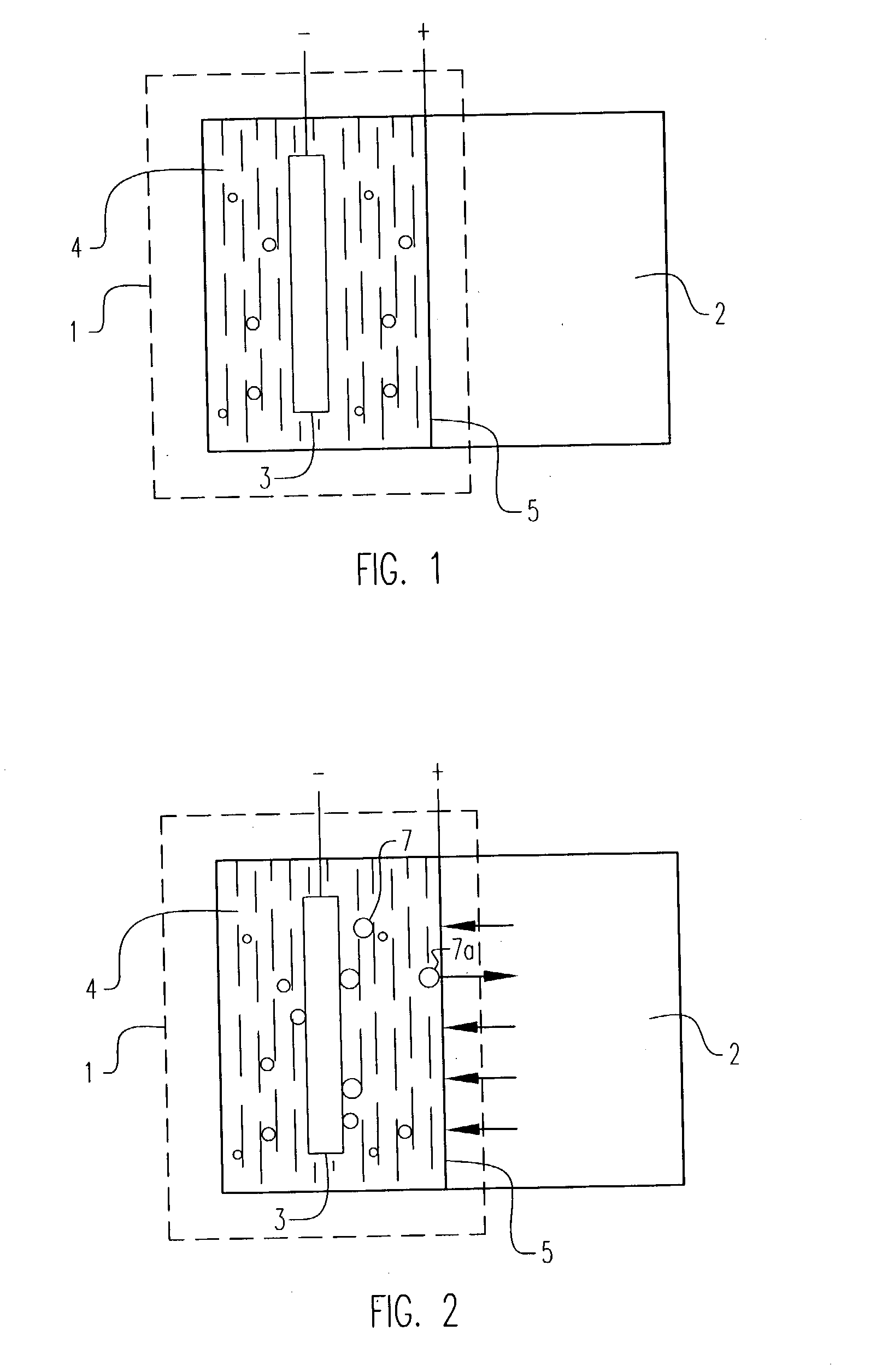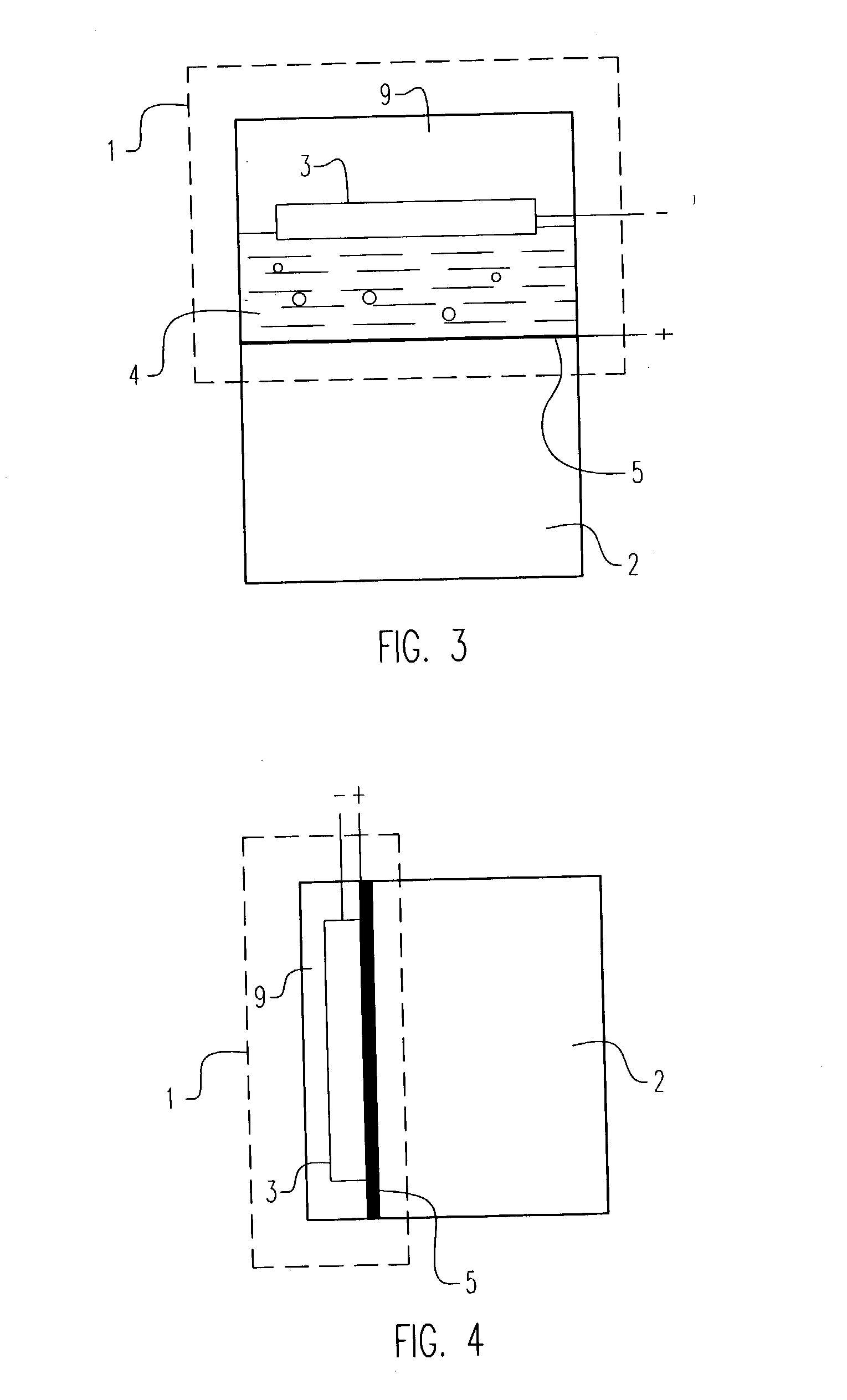Electrochemical pressurizer/purifier of hydrogen for operation at moderately elevated temperatures (including high-temperature electrochemical pump in a membrane generator of hydrogen
- Summary
- Abstract
- Description
- Claims
- Application Information
AI Technical Summary
Benefits of technology
Problems solved by technology
Method used
Image
Examples
example 1
[0050] An electrochemical cell was constructed using two standard 1 / 2 inch stainless steel blind pipe flanges. Stainless steel tubing was fitted to holes drilled through the flanges to provide gas inlet and outlet ports to each flange. The tubes were welded to the flange to provide leak-tight seals.
[0051] Leak-tight current collector / electrode assemblies were fabricated by diffusion bonding (see U.S. Pat. No. 5,904,754) a 0.001 inch thick.times.1.375 inch diameter Pd60 / Cu40 weight percent foil disc to one side of a copper washer (1.375 inch outside diameter.times.1.125 inch inside diameter.times.0.010 inch thick). The opposing side of the copper washer was diffusion bonded to a copper foil current collector containing two holes positioned to match the gas inlet and outlet ports in the flanges. A 100.times.100 mesh stainless steel wire cloth disc was included on the inside of the copper washer to provide a flowfield for gases and support the membrane electrode. The copper current col...
example 2
[0060] An electrochemical cell of the type described in Example 1 was used with the following modifications:
[0061] (a) The electrolyte / matrix was 1 inch in diameter
[0062] (b) The second gasket had a 1 inch diameter center hole
[0063] (c) The cathode / current collector was replaced with a 1 inch diameter porous nickel foam (Eltech Systems) against the electrolyte / matrix and nickel foil current collector. A 1 inch diameter 100.times.100 mesh nickel woven wire cloth disc was placed between the foam and foil.
[0064] The startup procedure described in Example 1 was followed except that the electrochemical cell was positioned with the electrodes horizontal and cathode on top. Measured cathodic hydrogen flows were within experimental error of the expected flows according to Faraday's Law. Hydrogen compression was verified by closing the cathode gas outlet valve an observing a constant current (0.12 A / cm.sup.2) cathodic pressure increase to 10 psig from an atmospheric pressure anode hydrogen f...
example 3
[0065] An electrochemical cell of the type described in Example 1 was fed a mixture of nominally 40% hydrogen / 60% nitrogen at atmospheric pressure resulting in a sub-atmospheric partial pressure of hydrogen of about 6 psia. Approximately 120 cc / min of this gas mixture was fed to the anode compartment of the electrochemical cell operating at ca. 2 amps. Outlet flows were 106 cc / min. and 14 cc / min. from the anode and cathode compartments, respectively, resulting in about 30% of the hydrogen feed recovered as pure hydrogen and compressed to atmospheric pressure.
[0066] The inlet flow of this atmospheric pressure gas mixture was reduced to about 34 cc / min. While still operating at ca. 2 amps, the outlet flows were about 20 cc / min. and 14 cc / min. from the anode and cathode, respectively, resulting in nearly 100% of the hydrogen feed recovered as pure hydrogen and compressed to atmospheric pressure. Further hydrogen compression was verified by closing the cathode gas outlet valve and obser...
PUM
| Property | Measurement | Unit |
|---|---|---|
| Temperature | aaaaa | aaaaa |
| Thickness | aaaaa | aaaaa |
| Angle | aaaaa | aaaaa |
Abstract
Description
Claims
Application Information
 Login to View More
Login to View More - R&D
- Intellectual Property
- Life Sciences
- Materials
- Tech Scout
- Unparalleled Data Quality
- Higher Quality Content
- 60% Fewer Hallucinations
Browse by: Latest US Patents, China's latest patents, Technical Efficacy Thesaurus, Application Domain, Technology Topic, Popular Technical Reports.
© 2025 PatSnap. All rights reserved.Legal|Privacy policy|Modern Slavery Act Transparency Statement|Sitemap|About US| Contact US: help@patsnap.com



